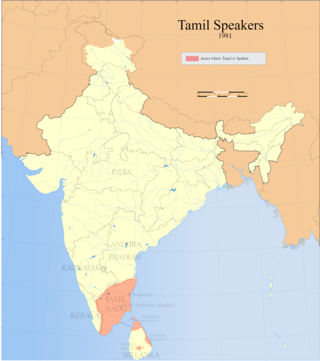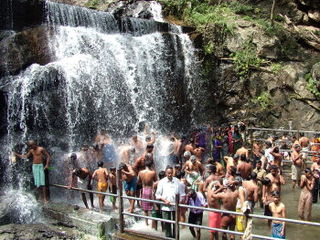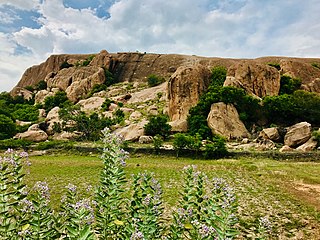Related Research Articles

Music of Tamil Nadu has a long tradition and history going back thousands of years. Music is a very important aspect of marriage and temple festival Tamil people.

Ilaiyangudi is a town in Sivaganga district, Tamil Nadu state, India. It is the center of government for the surrounding tehsils. The town has a predominant Tamil Rowthers population. The Tamil Muslim community was traditionally engaged in Business. Bazaar(Kadai Theru) is the central business district.

Tamil Muslims are Tamils who practise Islam. The community is 6 million in India, primarily in the state of Tamil Nadu where 90% of the Muslim community identified themselves as Tamils. In Tamil Nadu, the majority of Tamil-speaking Muslims belong to the Rowthers Community while other Muslims live in coastal Tamil Nadu. However, the majority of these individuals are native Tamils who converted influenced by Tajuddin Cheraman Perumal. There is a substantial diaspora, particularly in Southeast Asia, which has seen their presence as early as the 13th century. In the late 20th century, the diaspora expanded to Western Europe, Persian Gulf and North America. These Tamil speaking Muslim communities in Sri Lanka were known as the Sonakar, which is derived from the term Yona, originally meaning a Moors.

Sudha Ragunathan is an Indian Carnatic vocalist, singer and composer. She was conferred the Kalaimamani award by the Government of Tamil Nadu in 1994, Padma Shri (2004) and Padma Bhushan (2015) by the Government of India, and Sangeetha Kalanidhi by Madras Music Academy in 2013.
Gaana is a genre of Tamil music, which is sung in the Madras Bashai dialect of Chennai, Tamil Nadu, India. It is rap-like "collection of rhythms, beats and sensibilities native to the Madras people." It evolved over the past two centuries, with influences ranging from the siddhars of ancient Tamilakam to rural Tamil folk music to Tamil sufi mystics. Its popularity rose when it was brought to the music of the mainstream Tamil film industry. Contemporary gaana bands are bringing the genre to new audiences while using it for social activism, especially against caste discrimination.
Tondiarpet is a northern neighbourhood of Chennai, Tamil Nadu, India.

Suruli falls, is located 56 km (35 mi) from Theni and 10 km (6.2 mi) from Cumbum in the Theni District in Tamil Nadu, India. It is a 2 stage Cascading water fall. The Suruli River supplying the falls originates from the Meghamalai mountain range. The falls drop from a height of 150 feet (46 m) gathers into a pool, flows for a short distance and again plummets an additional 40 feet (12 m).

Sheikh Jamal-ud-Din Ahmad was a direct descendant of Imam Abu Hanifa, the renowned Sunni-Persian jurist of Islam. He was born at Ghazni, (Khorasan) which is in Modern-day Afghanistan, in 583 A.H.. He was five years old when his family came to Hansi. He became a disciple of Baba Fariduddin Ganjshakar at the age of 50. He learnt deeply and served devotedly.

Sheikh Noor Ul Mashaikh Sayyid Ahmed Muhiyuddin Jeelani NooriShah Arabic:, known more commonly as Sheikh NooriShah Jeelani, was a renowned 20th-century muslim, sufi, wali, mystic, orator, faqeeh, theologian, mujaddid and highly acclaimed Islamic scholar of the Qadri, Chisti order from the Indian sub continent. He was the 21st grand son of the famous Sufi saint Ghous-e-Azam Sheikh Mohiyudheen Abdul Qadir Jilani of Baghdad. He was also widely known by his title Noor-ul-Mashaikh. He was the Eponymous founder of the Silsila-e-Nooriya tariqa which is a sub-branch of Qadiriyya and Chistiyya in India.
This is a list of notable Islamic shrines in Tamil Nadu, a state of India.
Madrasatu l-‘Arūsiyyah is the oldest institution of Arabic and Islamic learning in the South Indian state of Tamil Nadu. It is situated in the coastal town and Islamic centre of Kilakarai. It was established in 1082 AH/1671 AD by the venerated Muslim savant and saint of the Arwi region, Shaikh Ṣadaqatullāh b. Sulaimān al-Qāhirī aṣ-Ṣiddiqī. He is known by the Arabic epithet Mādiḥu r-Rasūl. The Tamil-speaking Muslim masses and scholars of Tamil Nadu also refer to him as Appā in their discourse and literature.

Nagore Dargah is a dargah built over the tomb of the Sufi saint Shahul Hameed. It is located in Nagore, a coastal town in the South Indian state of Tamil Nadu. The outer doors of the dargah are kept open always, while the internal doors are open from 4:00 am to 06:00 am and from 6:00 pm to 10:00 pm. On Fridays, the doors are additionally kept open between 12:00 pm and 2:30 pm. Shahul Hamid is believed to have performed many miracles in Nagore, and cured the physical affliction of king Achuthappa Nayak, a 16th-century Hindu ruler of Thanjavur. He is locally referred to as Nagore Andavar, meaning the "Ruler of Nagore" and Qadir wali baba. Nagore dargah as it stands now, is believed to have been built by ardent devotees of Shahul Hamid, with major contribution from Hindus. There are five minarets in the dargah, with the Hindu Maratha ruler of Thanjavur Pratap Singh, building the tallest minaret. The dargah is a major pilgrimage centre that attracts pilgrims from both sufi Islam and Hinduism, symbolizing peaceful coexistence between the two religions.

Santhosh Narayanan is an Indian composer and musician in the Tamil film industry. He also composed music and songs for some Telugu and Malayalam movies.

Bala Murugan, better known by his stage name Gana Bala is an Indian playback singer in Tamil cinema. He rose to prominence after rendering the songs 'Aadi Pona Aavani' and 'Nadukadalula Kappala' from the soundtrack of Attakathi. He has predominantly sung songs belonging to the gaana genre of Tamil Nadu. He has been credited for reviving the gaana genre in Tamil Cinema after 'Thenisai Thendral' Deva. He has also penned lyrics for some of his songs.

Samanar Hills, also known as Samanar Malai or Amanarmalai or Melmalai, is a rocky stretch of hills located near Keelakuyilkudi village, 10 kilometres (6.2 mi) west of Madurai city, Tamil Nadu, India. They stretch east–west over 3 kilometers towards Muthupatti village. These rocky hillocks are home to many Jain and Hindu monuments. The hill has been declared as a protected monument by the Archaeological Survey of India.

Nund Rishi, also known as Sheikh Noor-ud-Din Noorani, Sheikh-Ul-Alam and by the title Alamdar-e-Kashmir, was a Kashmiri Sufi saint, mystic, poet and Islamic preacher. Nund Rishi was among the founders of the Rishi order, a Sufi tradition of the region. He influenced many spiritual teachers and saints, including Hamza Makhdoom, Resh Mir Sàeb, and Shamas Faqir.
Shah Mohammed Farid-ud-Din Baghdadi, also known by the honorary title Shah Sahib, sometimes spelled as Fareed-ud-Din, was the seventeenth century's Iraqi Sufi saint. He is believed to have propagated Islam in the Chenab Valley of Jammu and Kashmir. He left for Hejaz and offered the Hajj at Mecca, and subsequently travelled through Egypt and Sindh. Prior to his propagation of Islam in the valley, he travelled through Agra and then reached Kishtwar where he spread Islam around 1075 Hijri, corresponding to 1664 AD. He was 75 at that time.
References
- 1 2 3 4 5 6 7 Bayly, Susan (1989). Saints, goddesses, and kings : Muslims and Christians in South Indian Society, 1700-1900. Cambridge [England]: Cambridge University Press. ISBN 0-521-37201-1. OCLC 70781802.
- ↑ Valan, Antony Arul (2020). "Gana (Gānā)". Keywords for India : A Conceptual Lexicon for the 21st Century. London: Bloomsbury Publishing Plc. pp. 83–84. ISBN 978-1-350-03927-8. OCLC 1134074309.
- 1 2 3 4 5 6 V, Sriram (2013-09-03). "To sing like Mastan Sahib". The Hindu. ISSN 0971-751X . Retrieved 2021-03-29.
- 1 2 3 4 5 Zvelebil, Kamil (1974). Tamil literature. Wiesbaden: Harrassowitz. pp. 114–115. ISBN 3-447-01582-9. OCLC 3053475.
- ↑ Kan̲akavirāyar (1990). Kan̲akāpiṣēka mālai (in Tamil). Aintām Ulaka Islāmiyat Tamil̲ Ilakkiya Mānāṭu, Kīlakkarai.
- ↑ Vardhaman. Gyan Parampara Vol. 7 By Mahalingam ( Tamil) Vardhaman. p. 1.
- ↑ "NFSC Releases". Indian Folklife: A Quarterly Newsletter from National Folklore Support Centre. 28: 22. January 2008.